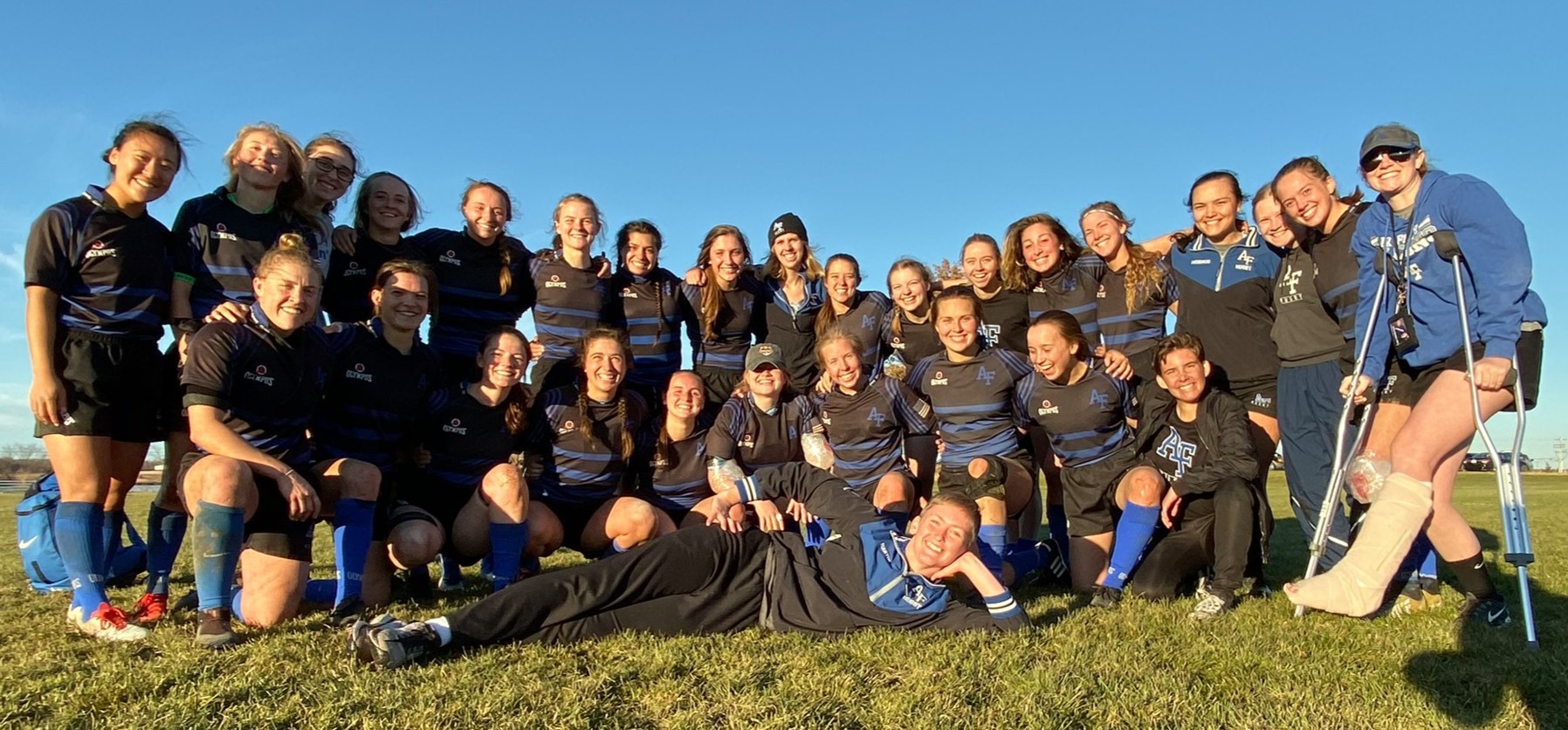
Photo courtesy USAFA Women’s Rugby Facebook
The U.S. Air Force Academy has featured in all but one of the USA Rugby DI Fall College Championship title matches since the seasonal competition formed in 2015. Paired with its successes in 7s, the Colorado Springs program has extensive, recent knowledge of what it takes to coalesce throughout a season, contend for a trophy, and build momentum for future classes.
RELATED: Navy Heads to DI Fall Championship
Firsties like Sarah Stinson, Jacqueline Hamby, Devin Doyle, Meghan Guinee and Kaylee Eskeli helped Air Force to its first DI fall 15s title in 2016, and they lead the way in terms of championship experience. But it’s not incumbent on them and fellow upperclassmen to educate their younger teammates on the pressures of knockout rugby.
“That is the mindset now; [the firsties] don’t have to impart anything. It’s part of their DNA and fabric now,” Air Force coach Amy Rusert said. “The upperclassmen are good about conveying [expectations at playoffs] but we have enough underclassmen who have been part of those teams, so we don’t need seniors to do that.
“Now that we’ve had some success in 15s and 7s at the championship level, it’s interesting to see some players have an affinity for one over the other,” the coach continued. “Some players took the 15s season off but are eager to defend their 7s title in the spring. It’s been an interesting development.”
Air Force began the year with close to 50 players, and did well to balance objectives of player development and A-side cohesion during the Rocky Mountain season. Air Force went 6-0 en route to the conference championship, outscoring opponents 524-81. Typically the team supplements its schedule with friendlies against BYU, the U.S. Military Academy and/or the U.S. Naval Academy, but those useful games did not occur this fall.
“What was interesting this season was our officials had very strong opinions about point differentials at halftime, say. There were some who didn’t necessarily heavily penalize us but held us to a different standard, maybe to level the playing field,” Rusert said. “But what they didn’t realize, particularly in our conference, is that we have a such a great relationship out there that we discuss [substitution strategies] with our opponents in advance, and we work it out so we have a really equitable second half.”
Air Force would run its top 15 together in the first half, because those players need that time together, and then make wholesale line changes in the second half, so both teams could enjoy some parity and the academy’s developing players could bank substantial A-side time. To boot, learning to adapt to these disruptive situations is a valuable process, and Air Force continually found ways to replicate these pressure scenarios. For example, the team might kick away possession when the situation might not necessarily call for it, and force the defense to regroup quickly.
The biggest push came from Wyoming, which finished runner-up in Rocky Mountain and then beat Texas A&M during the wild card round to advance to the DI fall quarterfinals. Wyoming inside center Jessica Gentle scored six tries against Air Force (and 49 against all fall competition) and asked big questions of the defense. The superlative ballcarrier helped refine the academy’s containment skills, which came in handy come regional championships.
The DI fall quarterfinals and semifinals occurred in Columbia, Mo., for the western portion of the bracket, and Poughkeepsie, N.Y., for the eastern half. Air Force beat Indiana 67-0 on day one and Minnesota 71-10 on day two. The semifinal victory against the Gophers required a hearty defensive stand toward the end of the game, and Rusert was pleased by the team’s response.
“We look to focus on 1-15 woman rugby. We don’t build shapes and strategies around key assets or key impact players. We know we have them but we don’t build around them; it’s full integration of 1-15,” Rusert said. “That’s what’s been exciting: They’re firing on all cylinders under this notion of ‘next woman up’ rugby – it’s a mantra. Because we’ve been able to incorporate developmental players in regular season and post-season games, we took a deep roster to Missouri and played different lineups. We had a slightly different look on day one and day two.”
Air Force has curated a group of utilitarian players, and some experimentation with positions has paid off. Former flanker Adrienne Yoder, for example, is a welcome addition to the centers and has scored close to 30 tries this fall. And when longtime back Eskeli requested a move into the back row this fall, the coaching staff embraced it.
“We move players around, but in the past those moves were predicated on team needs versus players making a conscientious move into a new role. Eskeli wanted to learn a new position and leave the 15s game a more versatile, well rounded player, and she’s been unbelievable. She’s not big in stature – although we got over that a long time ago,” said Rusert, who explained that last year’s big pack was an anomaly.
The Air Force scrum is typically outmatched in size, but not in physicality, and that disparity in mass doesn’t interfere with the coaching, planning or strategies.
“She’s a little bit of a thing, like an ant who can carry 10 times its weight,” Rusert returned to Eskeli. “We were so bowled over and impressed as coaches because sometimes those transitions can be tough. But the team looks at it like, ‘Yeah, of course. She was a great back and she is going to be a great forward.’”
Eskeli moved to No. 8 after Sierra DeHart’s last game on Nov. 3, and the team will make further adjustments as senior fullback Guinee incurred a season-ending injury in Missouri. The program hopes to bring several influential, injured players to Matthews, N.C., this weekend, especially firsties and especially those leaders who have helped Air Force to where it is today.
Otherwise, Air Force is feeling good, looking good, and the fact that Navy awaits in the final is a special trifecta for the Colorado team.
“It very much matters who the opponent is,” Rusert dispelled the notion that a final is a final. “With Navy, everything is heightened. When we were playing Minnesota in Missouri, we were following the Navy game at the same time and getting updates from Vassar. … As soon as Navy won, it was, ‘Let’s go sink Navy.’
“It’s a sister service academy, so there’s a mutual respect and admiration as opponents and peers, but then there’s also that really healthy dose of inter-service academy rivalry,” the coach added. “It’s an honor to be able to go back, and it’s doubly an honor to face Navy.”
The DI fall championship will occur on Sunday, Dec. 8 at 9 a.m. EST. Air Force doesn’t yet have its travel orders but hopes to arrive before Saturday so it can ready for the rigors of what will feel like a 7 a.m. kickoff. The game will be live-streamed via FloRugby.


